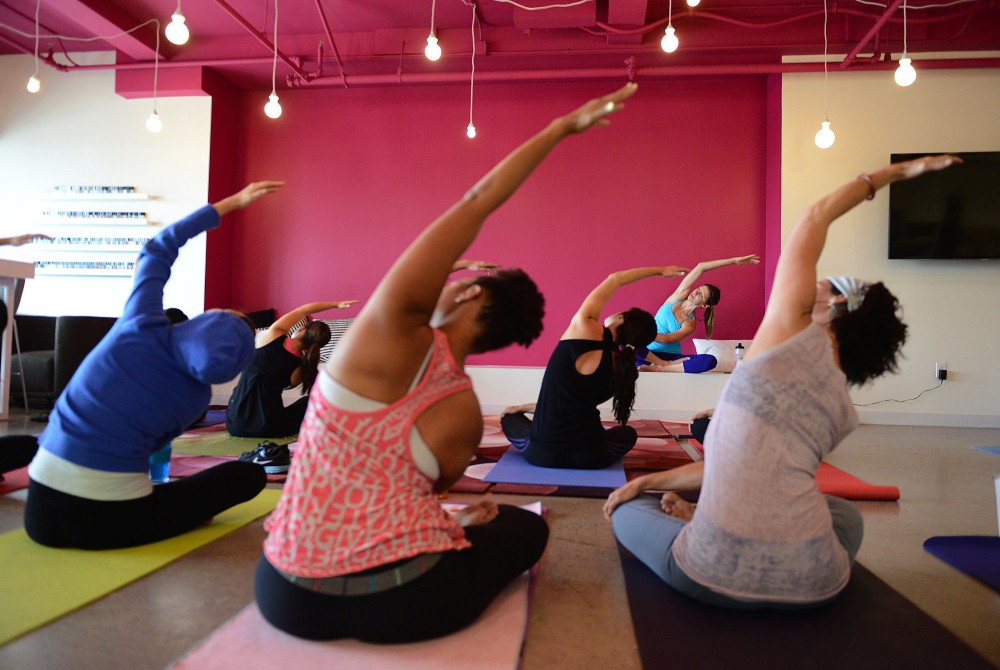By Jessica Belasco
San Antonio Express-News.
SAN ANTONIO
Most people think of yoga as a path to inner peace, relaxation, spiritual growth and meditation.
But for a small number, it’s less about the Om and more about beating out all the other yogis to win a gold medal.
Competitive yoga may sound like a contradiction in terms, but the participants are judged on their execution of asanas (poses), not how close they’ve come to achieving a state of Zen.
“Honestly, you’re not really competing against other people. You’re really competing against yourself,” said Shane Thornton, 38, who teaches Bikram yoga at the Union in San Antonio.
Thornton and more than 150 others from 36 states are competing in the 2014 National USA Yoga Asana Championship which began Friday and continues through Sunday at the Aztec Theatre.
This is the first year the national championship is being held in San Antonio.
The event is “a celebration of the beauty in the human form,” host Craig Villani said.
In other words, the audience gets to watch gorgeous men and women in tiny, skin-tight bathing suits put their legs behind their heads.
Fans of gymnastics and figure-skating will see a familiar structure at this event.
Participants execute five compulsory poses and two poses of their choosing.
Judges score each pose, looking for correct form, fluidity of movement, grace, control and stillness.
Trembling will knock points off a score.
So will loud, labored breathing or — worst of all — falling out of a pose.
Tiny details, such as pointing the toes or gazing skyward instead of at the floor, can make or break a competitor.
Each pose demands strength, flexibility and balance.
There’s a strict three-minute time limit to achieve the pose and demonstrate control of the asana.
The feats of flexibility and balance evoked occasional gasps from the audience Friday.
Competitors folded their legs in a lotus position while in a handstand.
They touched their noses nearly to their toes.
They held their bodies in the air perfectly parallel to the stage using only their forearms for support.
After Thornton finished a pose Friday in which he curved his spine in a backbend until his head rested on the floor between his feet, enthusiastic supporters cheered, clapped, whistled and stomped their feet.
Maybe it was the home court advantage or just lots of practice, but Thornton placed ninth in the pre-qualifiers, earning him a spot in the semi-finals Saturday.
Catherine Mondloch-Seavey, who also teaches yoga in San Antonio, placed sixth among 34 competitors in the women’s pre-qualifer.
This is the 11th annual national championship organized by USA Yoga, a nonprofit headquartered in Los Angeles that aims to become the country’s governing body for the sport of yoga asana.
The organization has lofty goals, the loftiest of which is to get yoga into the Olympics.
Rajashree Choudhury, founder of USA Yoga and wife of “hot yoga” superstar Bikram Choudhury, said competitions can motivate people — especially youths — to try yoga and keep improving.
In the Western world, yoga was introduced as a spiritual practice, and now it’s become a therapeutic wellness practice, Rajashree Choudhury said, but competitions have been held in India — where she’s from — for more than a century. She began yoga at age 4 and was a five-time national champion.
Gianna Purcell, the reigning women’s champion, said that when she started training for competition, it wasn’t because she wanted to beat out women who weren’t as skilled as twisting their bodies into unusual shapes.
“It was because I was really interested in expanding my own practice and becoming better at something that I decided to devote my life to,” said Purcell, 26, of Chicago. “The more I got into it, the more I’ve grown in understanding of myself and postures and mind-body awareness and connection.”
It’s typically people who practice Bikram yoga — a challenging form of yoga practiced in a room heated to 105 degrees — who participate in the USA yoga competitions.
Of course, such competitions have their detractors, who say such events contradict the intent of yoga.
“People outside the Bikram community roll their eyes,” said San Antonio yoga teacher Jill Wentworth, who briefly competed in 2010 but didn’t continue after she stopped practicing Bikram yoga.
“I feel like yoga is a very personal experience. As practitioners, we’re always striving to not think about what the pose is looking like but more how it’s feeling. I think competition takes away from that. I’ve always believed that anybody can practice yoga and receive the same benefits as the person that’s next to them, even if their pose doesn’t look like theirs. It was never meant in my opinion to be criticized and judged.”
But competitive yoga doesn’t contradict yoga’s goal of personal growth or mind-body connection, Choudhury said.
“Isn’t personal growth part of sport?” she said. “If you see the performances everyone is doing, whoever’s mind is not connected to their spirit, they are falling out of the poses. They cannot balance.”














































































































































































































































































































































































